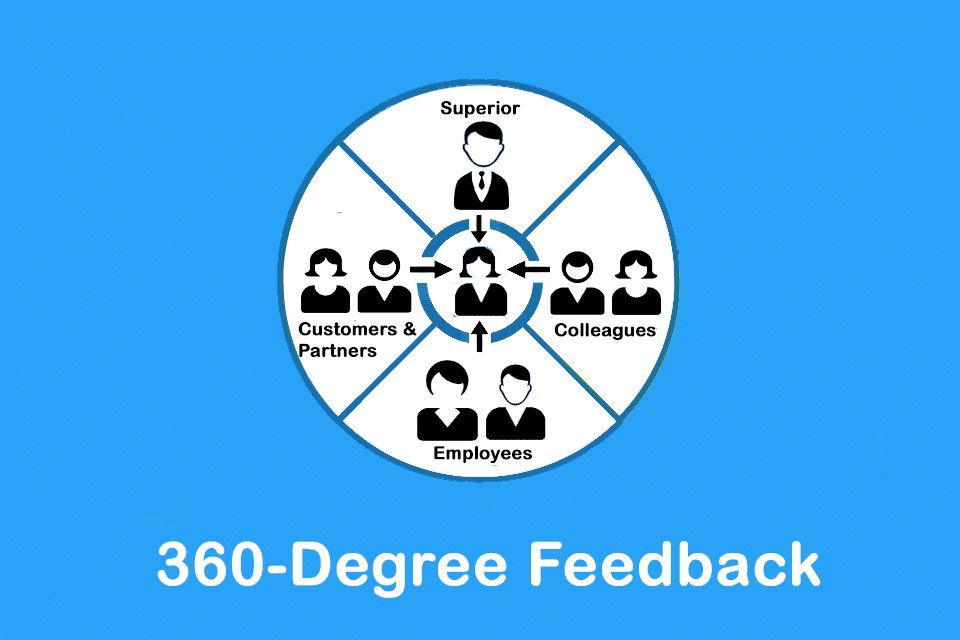What is 360-Degree Feedback?
Table of Contents: Definition – Levels – Phases – Advantages and disadvantages – Software – Notes
Smartpedia: 360-Degree Feedback is a format in which a person is assessed by superiors, employees, colleagues and customers or partners.
360-Degree Feedback – responses from different perspectives
“Most people are willing to learn, but very few are willing to be taught” Winston Churchill is reputed to have said. But this is exactly what happens in many appraisal situations: Supervisors lecture employees. The 360-Degree Feedback therefore chooses a different way of repsonse: not one person evaluates another, but several people reflect – ideally on the basis of defined criteria – on the behaviour, skills and knowledge of an individual person. In this way, the perspectives of
- superiors,
- colleagues,
- employees,
- internal and external customers, and
- partners
and, together with a self-assessment of the person, result in a complete, 360-degree assessment.¹
The founder of 360-Degree Feedback is Johann Baptist Rieffert, who built up the psychological service of the German Reichswehr and headed it from 1922 to 1931.² It was conceived as a sub-procedure for the selection of new officers, supplemented with opinions from comrades and psychologists, personality tests, and checks on skill, physical control, endurance, commitment, resourcefulness and community behaviour.³ In today’s work environments, other criteria are usually used for assessment.
Differences between different levels of feedback
If there is 360-Degree Feedback, there are also other degrees of feedback. Namely, these are as follows:
- 90-Degree Feedback: Here, in addition to a self-assessment by the feedback recipient, an assessment by another person takes place. It is important to compare the self-perception and the perception of others in order to determine deviations and identify potential for improvement. The feedback is given from one direction, i.e. the supervisor reflects on the employee, the employee assesses the supervisor or colleague A reflects on colleague B.
- 180-Degree Feedback: Here, in addition to the self-assessment, an assessment is made from two directions – by the direct supervisor and by the employee.
- 270-Degree Feedback: Here the 180-Degree Feedback is supplemented by the perspective of colleagues at the same hierarchical level.
- 360-Degree Feedback: In this form of feedback, external evaluations from customers – possibly also internal customers from other divisions or business units – or partners are added. So the feedback comes from four directions.
Interestingly, there are many organisations in practice that promote 360-Degree Feedback without integrating customers and partners. In most cases, therefore, it is probably more of a 180-Degree Feedback.
Basically, the formats that go beyond 90-Degree Feedback are called multi-rater or multi-source feedback. What is important here is the number of directions from which the feedback comes. Opinions vary as to whether, for example, ROTI Feedback is also considered multi-source feedback.4
The phases of the 360-Degree Feedback
There are usually five phases to 360-Degree Feedback:
1. Conception
In the conception phase, three main things are done:
- A questionnaire with standardised criteria and defined areas – competences, skills, potentials, etc. – is created by the HR department and/or an HR service provider. If necessary, a second questionnaire is also prepared for external participants, as they are to assess other aspects – e.g. customer friendliness, availability, processing speed and quality, etc.
- The feedback providers are identified and selected.
- All participants are informed about the procedure and any special features, such as the anonymisation of evaluations by employees in the direction of their superiors.
2. Conducting the survey
The questionnaires are sent out and a deadline for submission is set. Experience shows that reminders of the deadline and the granting of time allowances are useful.
3. Evaluation and analysis
The submissions are evaluated and analysed. Here it is important to identify commonalities in the evaluations and possible areas for improvement.
4. Communication of feedback
Here it is very important not to leave the person being assessed alone with the responses, but to accompany him or her in a concrete way. Time and again, resistance to individual judgements can be detected in people, which in individual cases even extends to anger at the 360-Degree Feedback or the person giving it. Here it may be necessary to mediate and gradually create acceptance. Acceptance is the basis for the last phase.
5. Developing a plan for improvement
Ideally, feedback helps to identify potential. These potentials need to be developed. Here it is advisable to draw up a plan with concrete measures and criteria for a defined period of time, and to observe or even coach the implementation and thus the development of the person. (For this reason, 360-Degree Feedback is also declared to be an instrument of personnel development).
Advantages and disadvantages of 360-Degree Feedback
360-Degree Feedback offers several advantages:
- Compared to 90-Degree Feedback, it offers a more complete picture with a higher significance.
- The comparison of external and self-assessment often reveals potential for improvement.
- Anonymised feedback from employees leads (at least in part) to more honest feedback, as those telling their opinions do not have to fear reprisals.
- By defining questions and criteria, the assessment is systematic and subsequently offers options to initiate improvements.
Indirectly, 360-degree feedback is a sign of a lived feedback culture. This is not an advantage in itself, but it is a good sign of open, constructive cooperation.
The advantages are also offset by some disadvantages:
- The format is very effort- and time-intensive. It should therefore ideally not be conducted in hot project phases or at the end of the year.
- Since it is not possible in larger organisations for everyone to assess everyone, the selection of those giving feedback can influence the assessment.
- Integrating external customers can be difficult, especially if the business relationship is not particularly stable and successful. Here it might be useful to have an exchange that does not target individuals but identifies and addresses common challenges.
And last but not least: without the accompaniment of the person being assessed, the format can do more harm than good. This in itself is not a disadvantage of the format, but rather describes a problem that can be observed in practice.
60-Degree Feedback Software
There are a number of tools available to help collect and use 360-degree feedback. Here you will find a small list:
- AssessTeam
- atwork
- Blue 360 Degree
- bonrepublik
- Culture Amp
- echospan
- Leapsome
- LoopNow
- PatPat360
- Primalogik
- robin mood
- Winningtemp
Certainly, the list can easily be extended, especially since there are numerous products that support feedback possibilities but originally have a different marketing focus.
Impulse to discuss
Is the fact that in many organisations feedback from employees towards superiors is anonymous a sign of a corporate culture where trust is lacking?
If you like the article or would like to discuss it, please feel free to share it in your network. And if you have any comments, please do not hesitate to send us a message.
[1] Some publications state that there is a separation between 360-Degree Feedback and 360-Degree Appraisal. While feedback refers to behaviour that can be learned and changed, assessment addresses personality traits and values that are difficult to change. In practice, however, this distinction is not shared by all experts.
[2] Johann Baptist Rieffert
[3] History of the 360-Degree Feedback
Here you can find a video about 360-Degree Feedback.
Here you will find additional information from the t2informatik Blog:



